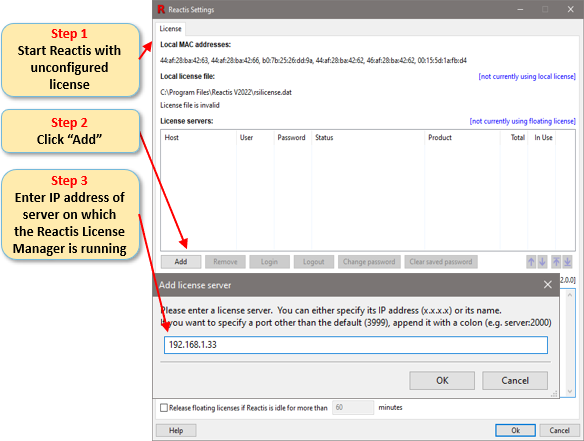2. Installing and Starting Reactis for Simulink#
Reactis is available on Windows®[1] and Linux®[2]. To run Reactis, a system should satisfy the following minimum requirements:
At least 1024 MB RAM (more is required for large models)
At least 230 MB free disk space
MATLAB, Simulink, and Stateflow installed
An installed Ethernet card
64-bit Reactis requires 64-bit Windows and 64-bit MATLAB
There are different methods for installing Reactis, depending on how you will access the license(s) you have purchased:
via a Reactis License File residing on your computer, or
via a Reactis License Manager running on a remote server.
In the latter case, you (or someone in your organization) will also need to install the Reactis License Manager. The Reactis installers may be downloaded from the Reactis User Pages:
https://reactive-systems.com/login.msp
2.1. Installing Reactis on Windows#
Reactis is available on Windows 11
2.1.1. Installing with Local License File#
To install Reactis, perform the following steps:
Execute the self-installing executable
reactis-setup-win64-V2025.2.0.exeand follow the instructions. You may download all Reactis installers from the Reactis User Pages. Note that an updated version of the installer will have a name of the formreactis-setup-win64-V2***.*.n.exewhere n is a patch release number.To obtain a Reactis license file, you will first need to locate the file
rsilicense.dat, which is stored in the Reactis installation directory. If you installed in the default location, the license file should be found at:C:\Program Files\Reactis V2025.2\rsilicense.dat
Once located, email the (incomplete) rsilicsense.dat to Reactive Systems
at help@reactive-systems.com. You will receive a response containing the
completed license as an attachment. When you receive this email, replace
rsilicense.dat in the Reactis installation directory with the completed
license file.
2.1.2. Installing with Remote License Manager#
If your organization already has a server running the Reactis License Manager, then you will need the name or IP address of the license server. The steps required to install Reactis on your computer (the client) are as follows:
On the client machine, run the installer (see step 1 of the Installing with Local License File section).
Invoke Reactis (see the Starting Reactis section). The dialog shown in Figure 2.1 will appear. In this dialog, click the Add button and enter the IP address or name of a server running the Reactis License Manager.
Step 2 can be repeated multiple times if there is more than one server running the Reactis License Manager.

Fig. 2.1 Configuring Reactis to access a Reactis License Manager running on a remote server.#
2.1.3. Installing the Reactis License Manager#
Please see the Reactis License Manager User’s Guide.
2.1.4. Performing a Silent Install#
The Reactis installer supports a silent install (installing Reactis from the DOS command line in an automated fashion). The following command line switches control a silent install.
Switch |
Description |
||||||||||||
|---|---|---|---|---|---|---|---|---|---|---|---|---|---|
|
Instructs the installer to be silent. When the installer is silent, the wizard and the background window are not displayed but the installation progress window and error messages are displayed. The default settings (which can be overridden using command line arguments) are used for the install. |
||||||||||||
|
With this switch, the installer will display error messages, but not the wizard, background window, or progress window. |
||||||||||||
|
Prevents the user from canceling during the installation process by disabling the Cancel button and ignoring clicks on the close button. This switch is useful in conjunction with /SILENT. |
||||||||||||
|
Overrides the default directory name displayed on the Select Destination Location wizard page. A fully qualified path name must be specified. |
||||||||||||
|
Overrides the default folder name displayed on the Select Start Menu Folder wizard page. |
||||||||||||
|
Overrides the default components settings. By default, all components are installed. Possible components are:
|
||||||||||||
|
Overrides the default MATLAB root directory name displayed on the Locate MATLAB wizard page. |
||||||||||||
|
Use |
||||||||||||
|
Instructs the installer to copy the personal settings and license information to the new installation if running in SILENT or VERYSILENT mode and a previous existing Reactis installation is found. This is the default. |
||||||||||||
|
Do NOT copy personal settings and license information from a previous existing installation. |
||||||||||||
|
Saves information entered during the install in a file. That file can later be used to specify default parameters via LOADINF. The following information is saved:
|
||||||||||||
|
Load default information from a file created with the SAVEINF option. This is useful in combination with a silent install, i.e. C:\> reactis-setup-V2025.0.0.exe /SILENT /LOADINF="mysetup.inf"
will install Reactis without any user prompts using the values saved in
|
||||||||||||
|
Display help information for the silent install command line switches. |
2.2. Installing Reactis on Linux#
Reactis is also available on Linux. Currently the following limitations apply:
Only the Reactis for Simulink API is supported. The Reactis GUI is not yet available on Linux.
Reactis has been tested on Ubuntu Linux 22.04 LTS. Other Ubuntu versions and Linux distributions may work but have not officially been tested.
Reactis on Linux requires MATLAB R2016b or later.
2.2.1. Performing a System-Wide Install#
Download the installer script
reactis-setup-glx64-V2025.2.0.sh. You may download all Reactis installers from the Reactis User Pages.Within a Linux shell, execute the following command
sudo bash reactis-setup-glx64-V2025.2.0.shand follow the instructions. Note that running this will require root privileges on the Linux machine. If you do not have such privileges you may install Reactis in your user account following the instructions below.Set up Reactis to access a license as described below.
2.2.2. Performing a Single User Install#
Download the installer script
reactis-setup-glx64-V2025.2.0.sh. You may download all Reactis installers from the Reactis User Pages.Within a Linux shell, execute the following command
bash reactis-setup-glx64-V2025.2.0.shand follow the instructions.Set up Reactis to access a license as described below.
2.2.3. Installer Script Options#
When following the install instructions above, you may supply a number of parameters directly instead of interactively entering the settings. This allows for automated, silent installs. The following options are available:
Option |
Description |
|---|---|
|
Install Reactis to directory DIR/Vxxxx.y (where xxxx.y is the Reactis release number).
e.g. |
|
Install Reactis to directory DIR. Only one of –prefix and –home can be specified.
|
|
Configure Reactis to use the MATLAB version installed in DIR. |
|
Install Reactis system-wide. |
|
Install Reactis for current user only. |
|
Run installer non-interactively. Several arguments are required for a batch run: reactis-setup-glx64-V2025.sh --batch {--prefix DIR | --home DIR} --matlab-home DIR \\
{--system | --user} --accept-license
|
|
Acknowledge that you accept the terms of the Reactis Software License Agreement |
|
Display help information and exit. |
2.2.4. Configuring Reactis to access a license#
Reactis can access two different types of licenses:
Node-locked licenses. If you are installing a Reactis demo or your organization has purchased a node-locked license, follow these steps to configure Reactis:
Locate the Reactis license file stub created by the installer. If you used the default directories during installation, the license file can be found in the following location:
System-wide install
/opt/reactis/V2025.2/rsilicense.datSingle-user install
~/reactis/V2025.2/rsilicense.datEmail the (incomplete)
rsilicsense.datto Reactive Systems athelp@reactive-systems.com. You will receive a response containing the completed license as an attachment.Replace
rsilicense.datin the Reactis installation directory with the completed license file.
Concurrent licenses. If your organization has a server running the Reactis License Manager, then you will need the name or IP address of the license server. The steps required to install Reactis on your computer (the client) are as follows:
Start MATLAB and set up the MATLAB search path to access the Reactis API. You can do this by issuing the following from the MATLAB command line:
>> addpath('/opt/reactis/V2025/lib/api/MATLAB/reactis')
Confirm MATLAB is configured correctly by typing
rsVersion. This should returnV2025.2.Call the Reactis API function to set the license manager address:
rsSetParameterValue('LicenseServer', 'HOST')where HOST is the IP address or name of the server running the Reactis License Manager software.
2.2.5. Creating a Reactis Docker Image#
A Reactis Docker image must be based on an existing MATLAB image. The MATLAB image must contain at least the Simulink and Stateflow toolboxes to allow Reactis to function properly. Additionally, the MATLAB image must be set up such that MATLAB starts up without asking for user credentials (i.e. no online licensing).
Note that when running within a Docker image, Reactis requires a concurrent license. Your organization must have the Reactis License Manager software running on a server accessible by the computer running the Reactis Docker image. The host name or IP address of that server is referenced below as LICENSEHOST.
To create the Reactis Docker image:
Acquire a Docker image in which MATLAB is installed. The MATLAB installation within the image must adhere to the requirements given in the first paragraph of this section. A MATLAB image can be created by following the MathWorks instructions.
Download the Reactis Dockerfile
reactis-glx64-V2025.2.dockerand Reactis installer scriptreactis-setup-glx64-V2025.2.0.sh. These files can be found in downloads section of the Reactis User Pages.Rename the Reactis installer script to
reactis-setup-glx64-V2025.2.sh.Within the folder in which the Reactis dockerfile and installer script are located, run the following command:
docker build -t reactis:V2025.2 -f reactis-glx64-V2025.2.docker --build-arg MATLAB_RELEASE=r2024a --build-arg REACTIS_VERSION=V2025.2 .This should successfully build the Reactis Docker image containing MATLAB R2024a and Reactis V2025.2. If errors occur you may have to adjust configuration options (see below).
Start the Reactis Docker image:
docker run -it -e REACTIS_LICENSE_SERVER=LICENSEHOST --rm reactis:V2025.2(REACTIS_LICENSE_SERVER must be the IP address or host name of a computer running the Reactis License Manager). The image should start up and present the MATLAB startup message and command prompt
Execute the following on the MATLAB command line to test the Reactis API startup:
rsVersion(); rsOpen();
Both should finish without errors.
The Reactis Dockerfile provides the following configuration options. These can be changed either within the Dockerfile itself or by supplying “–build-arg” to the “docker build” command (which overrides the defaults given in the Reactis Dockerfile):
Option |
Default |
Description |
|---|---|---|
REACTIS_VERSION |
V2025 |
This is the Reactis version to use for the Docker image. Only Reactis V2024 and later are supported. |
REACTIS_LICENSE_SERVER |
none |
Specify the Reactis license server that should be used to acquire the Reactis license. This can be overridden at runtime by giving a “-e REACTIS_LICENSE_SERVER=…” argument to the “docker run” command. |
MATLAB_RELEASE |
R2024a |
This is the MATLAB release on which the Reactis image should be based. Use this setting if you created the MATLAB base image using the Dockerfile provided by MathWorks. |
MATLAB_IMAGE |
matlab:$MATLAB_RELEASE |
This directly specifies the MATLAB base image name. Use this setting if your MATLAB base image name does not follow the default naming or is not stored locally. |
MATLAB_INSTALL_LOCATION |
/opt/matlab/$MATLAB_RELEASE |
Specifies the root folder in which MATLAB is installed within the MATLAB base image. Use this setting if MATLAB is installed in a non-standard location. |
2.3. Starting Reactis#
Reactis can be started in several ways:
Select Reactis V2025.2 from the Windows Start menu, or
double-click on the desktop shortcut if you installed one, or
call the reactis.exe executable from a DOS command prompt which can be invoked with zero, one, or two arguments:
If no arguments are given Reactis starts with no model loaded.
If one argument is given it can be either the name of a Simulink model (.mdl or .slx file) or the name of an .rsi file. Reactis will start and load the specified model.
If two arguments are given the first is assumed to be a model name and the second is an .rsi file and Reactis will start and load the specified model and .rsi file.
